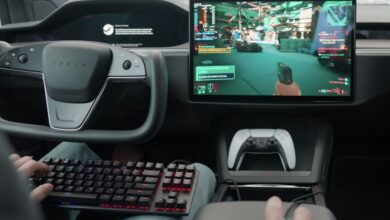Asus ROG Flow X13 and XG Mobile hands-on: A one-two punch from AMD and Nvidia

[ad_1]
Lori Grunin/CNET
Some people like their laptops tiny and light, some like them powerful and some like them flexible. Asus takes a nifty approach in its $3,000 attempt to be all things to all people with its ROG Flow X13, a 13.3-inch, 2.9-pound two-in-one laptop paired with the new XG Mobile, a compact external-GPU-plus-dock combo device.
The surprisingly fast new AMD processor in the laptop and unsurprisingly fast new Nvidia GPU in the external module combine to make a machine that transforms seamlessly from a mobile workhorse to a gaming powerhouse. And unlike Lenovo’s thin-and-light lightweight gaming laptop with an external graphics processor, you can still get in some decent gameplay without the eGPU, because it doesn’t ditch the internal GTX 1650.
I managed to get in some testing over the few days I’ve had the duo so far. I liked using it — until I ran into issues that felt like the tech equivalent of backing up over traffic spikes. I’m waiting to hear back from Asus, but I suspect the problem is there’s just too much new here and possibly a misconfigured or too-early evaluation unit.

The XG Mobile has both full-size HDMI and DisplayPort connections, an Ethernet jack, four USB-A ports and a UHS-II SD card slot.
Lori Grunin/CNET
The laptop incorporates one of the new generation of AMD mobile gaming processors, in this case the eight-core, 35-watt Ryzen 9 5900HS, in a newish two-in-one design and with a new proprietary architecture for connecting the XG Mobile combo external GPU and dock. The model I tested is the $3,000 lower-end option (yes, $3K is the low end; it converts to about £2,185 or AU$3,875). Asus will also offer a Ryzen 9 5980HS and UHD screen option.
The XG Mobile uses the new Nvidia GeForce RTX 3080 mobile chip, and its own 280-watt power supply that can drive the laptop. Those are a lot of cutting-edge pieces to fit together. Because it uses the mobile Nvidia part, the XG Mobile is relatively small: 55 by 208 by 29 millimeters, and 2.2 pounds (1 kg).
During my preliminary testing of both systems, the GPU performed at least as well as the same RTX 3080 in the Origin PC Evo17-S. Sometimes it outperformed it. That’s partly to be expected, since the GPU doesn’t have to worry about the same cooling issues as it does in the thin (but still substantially larger) Evo17-S. And that’s before Asus’ expected BIOS update, which will enable Resizable BAR support and should give some games a nice boost.

Asus includes some nice sleeves for your $3,000.
Lori Grunin/CNET
The Ryzen 9 5900HS processor turned in AMD’s usual stellar multicore performance, as well as excellent single-core performance, even compared to the Intel Core i7-10870H in the Evo17-S. The Ryzen 9 5980HS model should blow past it entirely. (I don’t have any results for the Core i9-10885H, which is a more direct competitor.)
How do the two parts of this package hook up? The cable between the laptop and the eGPU has two connectors: There’s a dedicated PCIe path between the RTX 3080 and the laptop, plus a USB-C port with power delivery and DisplayPort support. When not attached to the XG, the USB-C half of the connector works as… a USB-C port.
There are a few reasons why Thunderbolt wouldn’t have worked for an eGPU. For one, It throttles the connection between the GPU and the main system, and splits the bandwidth among the other connections. That means it couldn’t power the hub without taking a hit. Plus, when the eGPU is connected, the system disables the integrated GPU, so it can allocate the power savings to the eGPU. And there’s an even more notable reason: AMD doesn’t support Thunderbolt.
The laptop and eGPU have nice physical designs as well. You don’t get as much illumination as you would with a dedicated gaming laptop, just a red glow from the fan in the eGPU. The keyboard is far more oriented to work than play.
I’ve got miles to go before I can put a review to sleep on this one, starting with ironing out problems with my test unit. But stay tuned. When it works, this is a great, albeit expensive solution for people who want to balance work with playing heavyweight games on an external monitor. You can sign up to get a notification when it’s available on Asus’ site.
[ad_2]
Source link







